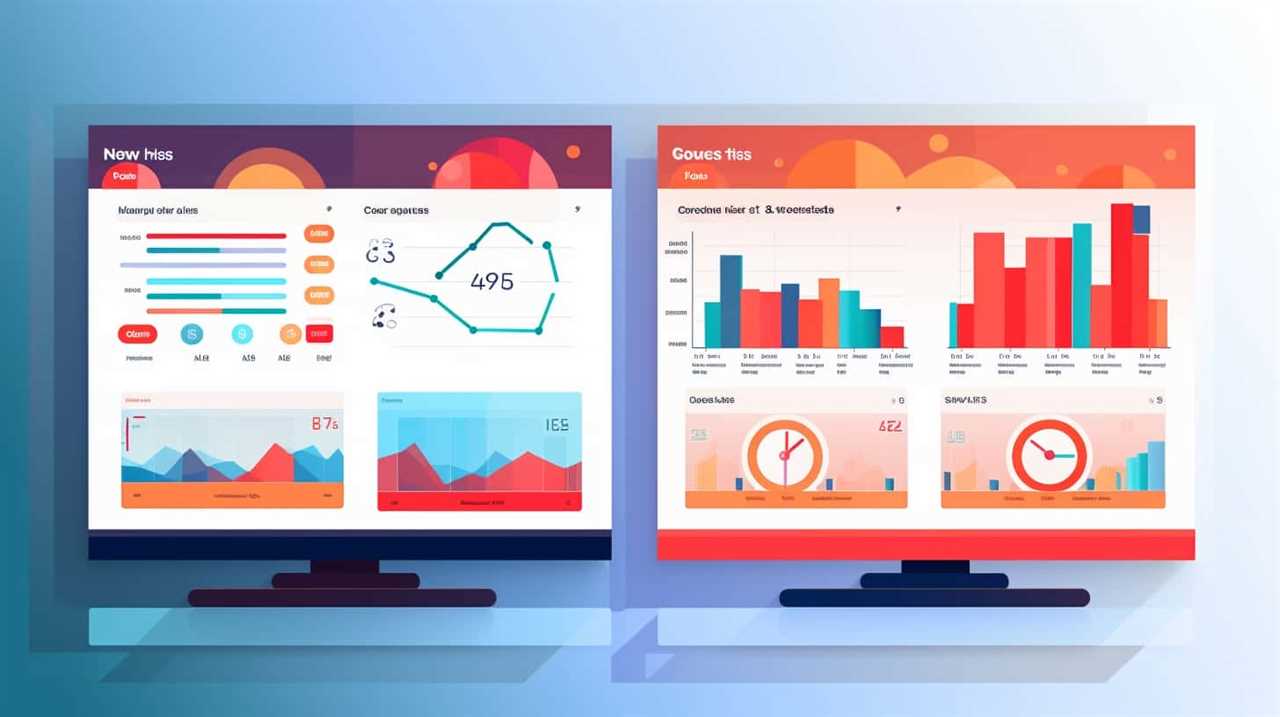I’ve unlocked the key to enhancing your digital strategy as a custom hat maker. It focuses on fully leveraging the power of Google Ads.
With targeted audience reach, increased brand visibility, and optimized ad copy, you’ll be driving quality traffic to your website and maximizing your return on investment.
But that’s not all.
Mobile optimization and campaign analysis will help you stay ahead of the competition.

Get ready to take your online presence to new heights with Google Ads.
Key Takeaways
- Audience segmentation is crucial for successful advertising campaigns.
- Social media marketing helps increase brand visibility and engage with potential customers.
- Search engine optimization improves website visibility in search engine results.
- Measuring campaign success accurately through KPIs helps maximize ROI.
Targeting the Right Audience
To effectively reach potential customers, I target the right audience for my bespoke hat making business using Google Ads. Audience segmentation is a crucial aspect of any successful advertising campaign. By dividing the market into distinct groups based on characteristics such as demographics, interests, and online behavior, I’m able to tailor my ads to specific segments that are most likely to be interested in my handmade hats.
One of the ad targeting strategies I employ is keyword targeting. By selecting relevant keywords related to hat styles, fashion trends, and luxury accessories, I ensure that my ads are displayed to users who are actively searching for these terms. This increases the chances of reaching individuals who are already interested in purchasing bespoke hats.
In addition to keyword targeting, I also utilize demographic targeting. By analyzing data on age, gender, location, and income level, I can refine my ads to target specific demographics that are more likely to have an interest in my hats. For example, I may target affluent individuals in major cities who’ve shown an interest in high-end fashion.

Increasing Brand Visibility
By increasing brand visibility through targeted audience segmentation and ad targeting strategies, I am able to effectively showcase my bespoke hat making business to potential customers. Building brand authority is crucial in establishing credibility and trust among customers. One effective way to increase brand visibility is through social media marketing. Utilizing platforms such as Instagram and Facebook allows me to reach a wider audience and engage with potential customers on a more personal level.
To further illustrate the importance of increasing brand visibility, consider the following table:
| Benefits of Increasing Brand Visibility |
|---|
| 1. Increased brand recognition |
| 2. Enhanced customer trust |
| 3. Expanded customer base |
By building brand authority and utilizing social media marketing, I can tap into the power of online platforms to promote my bespoke hat making business. This not only helps me reach a wider audience, but also establishes my expertise and credibility in the industry.
As I focus on increasing brand visibility, the next step is driving quality traffic to my website. By implementing effective strategies such as search engine optimization and targeted advertising, I can ensure that the right audience is directed to my website, increasing the chances of conversions and sales.

Driving Quality Traffic to Your Website
After increasing brand visibility, I can now focus on driving quality traffic to my website through effective strategies such as search engine optimization and targeted advertising. To improve conversion rates and attract the right audience, it’s crucial to optimize my website for search engines. This involves researching keywords relevant to my bespoke hat business and incorporating them into my website content, meta tags, and headers. By doing so, I can increase my website’s visibility in search engine results, making it easier for potential customers to find me.
Another effective strategy is using remarketing techniques. This involves showing targeted ads to people who’ve already visited my website but haven’t made a purchase. By using tools like Google Ads, I can display personalized ads to these potential customers as they browse other websites. This keeps my brand at the forefront of their minds and encourages them to return to my website to complete their purchase.
Maximizing Return on Investment (ROI)
In order to maximize my return on investment (ROI), I’ll focus on optimizing my marketing campaigns and website further. One crucial aspect of maximizing ROI is measuring campaign success accurately. By analyzing key performance indicators (KPIs) such as click-through rates (CTR), conversion rates, and cost per acquisition (CPA), I can identify which campaigns are delivering the best results. This data will allow me to allocate my budget more effectively, directing more funds towards high-performing campaigns and eliminating or adjusting underperforming ones.
Another area to consider when maximizing ROI is budget allocation. It’s essential to allocate my budget strategically to ensure that I’m getting the most out of every dollar spent. By monitoring the performance of different campaigns and channels, I can identify where my budget is best utilized and make adjustments accordingly. This might involve reallocating funds from less effective channels to those that are driving the most conversions and revenue.

By focusing on measuring campaign success and optimizing budget allocation, I can make data-driven decisions that will enhance my ROI. These strategies will help me identify the most effective marketing campaigns and channels, allowing me to allocate my budget wisely for maximum impact.
With a solid foundation in place, I can now move forward into the next section and discuss the importance of creating compelling ad copy that grabs the attention of potential customers.
Creating Compelling Ad Copy
When it comes to creating compelling ad copy, two key elements stand out: captivating headlines and effective call-to-action phrases.
The headline is the first thing potential customers see, so it needs to grab their attention and entice them to click.

A strong call-to-action then prompts them to take the desired action, whether it’s making a purchase or signing up for a newsletter.
In this discussion, we’ll explore strategies for crafting headlines that captivate and call-to-action phrases that convert.
Captivating Headlines for Ads
I craft captivating headlines for my ads to create compelling ad copy that grabs attention. In the world of online advertising, capturing the interest of potential customers is the key to success. A well-crafted headline can make all the difference in the level of engagement your ads receive.
To create captivating headlines, I employ various techniques that have been proven to be effective. One technique is to use numbers or statistics in the headline, as they can pique curiosity and make the ad more credible. Another technique is to create a sense of urgency by using words like ‘limited time offer’ or ‘exclusive deal’ in the headline. Additionally, asking a thought-provoking question or using a bold statement can also captivate the reader’s attention.

Effective Call-To-Action Phrases
To create compelling ad copy, it’s essential to incorporate effective call-to-action phrases that motivate potential customers to take action. These phrases act as a bridge between your ad and your desired outcome, encouraging users to engage with your brand.
To evoke an emotional response in your audience, consider using the following techniques:
- Create a sense of urgency: Use phrases like ‘Limited time offer’ or ‘Don’t miss out’ to make customers feel like they need to act now.
- Offer exclusive benefits: Highlight unique features or benefits of your product or service that your competitors don’t have, such as ‘Get access to our exclusive collection’ or ‘Unlock special discounts.’
- Use persuasive language: Craft your call-to-action phrases using strong verbs and persuasive language that encourages users to take action, like ‘Shop now,’ ‘Discover the perfect hat,’ or ‘Start customizing your own design.’
Optimizing Ads for Mobile Devices
When it comes to optimizing ads for mobile devices, there are a few key points to keep in mind.
First, it’s important to design responsive ads that adapt to different screen sizes and orientations. This ensures that your ads look great and are easy to navigate on mobile devices.

Second, make sure your landing pages are mobile-friendly, with fast loading times and clear calls to action.
Finally, don’t forget to target mobile users specifically, using location targeting and mobile-specific keywords to reach the right audience.
Responsive Ad Designs
With the rise of mobile usage, optimizing ads for mobile devices has become essential for bespoke hat makers using Google Ads. Responsive ad designs ensure that your ads look great and perform well on any screen size.
Here are three reasons why responsive ad designs are crucial for your online strategy:

- Improved user experience: Mobile users expect a seamless browsing experience. Responsive ad designs adapt to different screen sizes, making it easier for users to engage with your ads and navigate your website.
- Higher conversion rates: When your ads are optimized for mobile, they load faster and are more visually appealing. This leads to higher click-through rates and conversions, ultimately boosting your sales and revenue.
- Increased ad visibility: Google favors mobile-friendly ads and websites in search rankings. By investing in responsive ad designs, you can improve your ad visibility and attract more potential customers.
Now that we understand the importance of responsive ad designs, let’s dive into creating mobile-friendly landing pages to further enhance your online presence.
Mobile-Friendly Landing Pages
Now let’s explore the importance of creating mobile-friendly landing pages to optimize ads for mobile devices.
Mobile optimization is crucial in today’s digital landscape, where more and more users are accessing the internet through their smartphones and tablets.
When users click on your ad, they expect a seamless and user-friendly experience on their mobile devices. If your landing page isn’t optimized for mobile, you risk losing potential customers and wasting your advertising budget.

A mobile-friendly landing page ensures that your content is displayed correctly and is easy to navigate on smaller screens. It enhances the user experience, making it more likely for users to engage with your website and take the desired action.
Targeting Mobile Users
One way to optimize ads for mobile devices is by targeting mobile users. Mobile advertising has become increasingly important as more and more people use their smartphones and tablets to browse the internet. To effectively reach this audience, it’s essential to tailor your ads specifically for mobile devices.
Here are three strategies to consider:
- Responsive design: Ensure that your ad creative is designed to be mobile-friendly, with clear and concise messaging that’s easy to read on smaller screens.
- Location targeting: Use geolocation data to target users who are in close proximity to your physical store or who are located in areas where your target audience is more likely to be.
- App targeting: Take advantage of the growing number of mobile apps by targeting users who’ve downloaded relevant apps or have shown interest in similar products or services.
Tracking and Analyzing Campaign Performance
As a bespoke hat maker, it’s crucial to understand the impact of your advertising efforts and how they resonate with your target audience. Tracking ad performance and analyzing customer behavior are essential components of a successful online strategy.

Google Ads provides a range of tools and metrics to help you monitor the effectiveness of your campaigns. With conversion tracking, you can measure the actions that users take after clicking on your ads, such as making a purchase or filling out a contact form. This data allows you to identify which ads and keywords are driving the most valuable traffic to your website.
Furthermore, Google Analytics provides valuable insights into customer behavior on your website. You can analyze metrics like bounce rate, time on site, and conversion rate to understand how users engage with your hats. This information can help you make data-driven decisions to optimize your campaigns and improve your website’s user experience.
By closely tracking and analyzing your campaign performance, you can identify areas for improvement and refine your targeting and messaging. This will ultimately lead to more effective ads, increased conversions, and a higher return on investment for your bespoke hat making business.
Staying Ahead of the Competition
To outperform competitors, I continuously analyze market trends and adapt my Google Ads strategy as a bespoke hat maker. Staying ahead of the competition requires staying on top of current industry trends and consumer demands. Here are three key strategies I employ to maintain a competitive edge:

- Competitive pricing: In the world of bespoke hat making, pricing can play a significant role in attracting customers. By offering competitive prices without compromising on quality, I’m able to stand out from my competitors. I regularly research and compare prices to ensure that my pricing remains competitive in the market.
- Social media marketing: A strong presence on social media platforms is crucial for any business in today’s digital age. I leverage social media to not only showcase my unique hat designs but also engage with my target audience. By consistently posting high-quality content, collaborating with influencers, and running targeted ads, I’m able to increase brand visibility and reach a wider audience.
- Continuous innovation: To stay ahead of the competition, I’m constantly seeking ways to innovate and differentiate my products. I keep a close eye on emerging trends and customer preferences, allowing me to introduce fresh designs and styles that appeal to my target market. By offering unique and innovative hat designs, I’m able to attract customers who are looking for something truly distinctive.
Frequently Asked Questions
How Can I Effectively Target a Niche Audience of Hat Enthusiasts for My Bespoke Hat Business?
To effectively target hat enthusiasts for my bespoke hat business, I utilize targeting techniques like keyword research, location targeting, and audience segmentation. By engaging hat enthusiasts with compelling ad copy and visually appealing designs, I can attract and convert them into loyal customers.
What Strategies Can I Implement to Increase Brand Visibility and Awareness for My Bespoke Hat Brand?
To increase brand visibility and awareness for my bespoke hat brand, I can implement strategies like social media promotion and influencer collaborations. These tactics will help me reach a wider audience and establish my brand as a leader in the industry.
How Can I Drive Quality Traffic to My Website and Ensure That Potential Customers Are Genuinely Interested in My Bespoke Hats?
To drive qualified traffic and increase website conversions, it’s crucial to target potential customers who are genuinely interested in bespoke hats. This can be achieved through strategic marketing tactics and optimizing online content.
What Are Some Effective Ways to Maximize Return on Investment (Roi) for My Google Ads Campaigns as a Bespoke Hat Maker?
To maximize my ROI for Google Ads, I focus on maximizing my ad budget and implementing effective ad targeting strategies. By carefully allocating my resources and reaching the right audience, I ensure the best return on my investment.

How Can I Create Compelling and Persuasive Ad Copy That Will Attract Potential Customers to Click on My Ads and Explore My Bespoke Hat Offerings?
To create compelling ad copy, I use persuasive language and highlight the unique features of my bespoke hats. I also incorporate a call to action and use emotional triggers to attract potential customers and increase click-through rates.
Conclusion
In the world of online advertising, Google Ads can be the secret ingredient that takes your bespoke hat making business to new heights. Just like a well-crafted hat adds the perfect finishing touch to an outfit, Google Ads can top off your online strategy by targeting the right audience, increasing brand visibility, and driving quality traffic to your website.
With careful tracking and analysis, you can stay ahead of the competition and maximize your return on investment. So don’t miss out on this opportunity to showcase your unique creations to the world.










